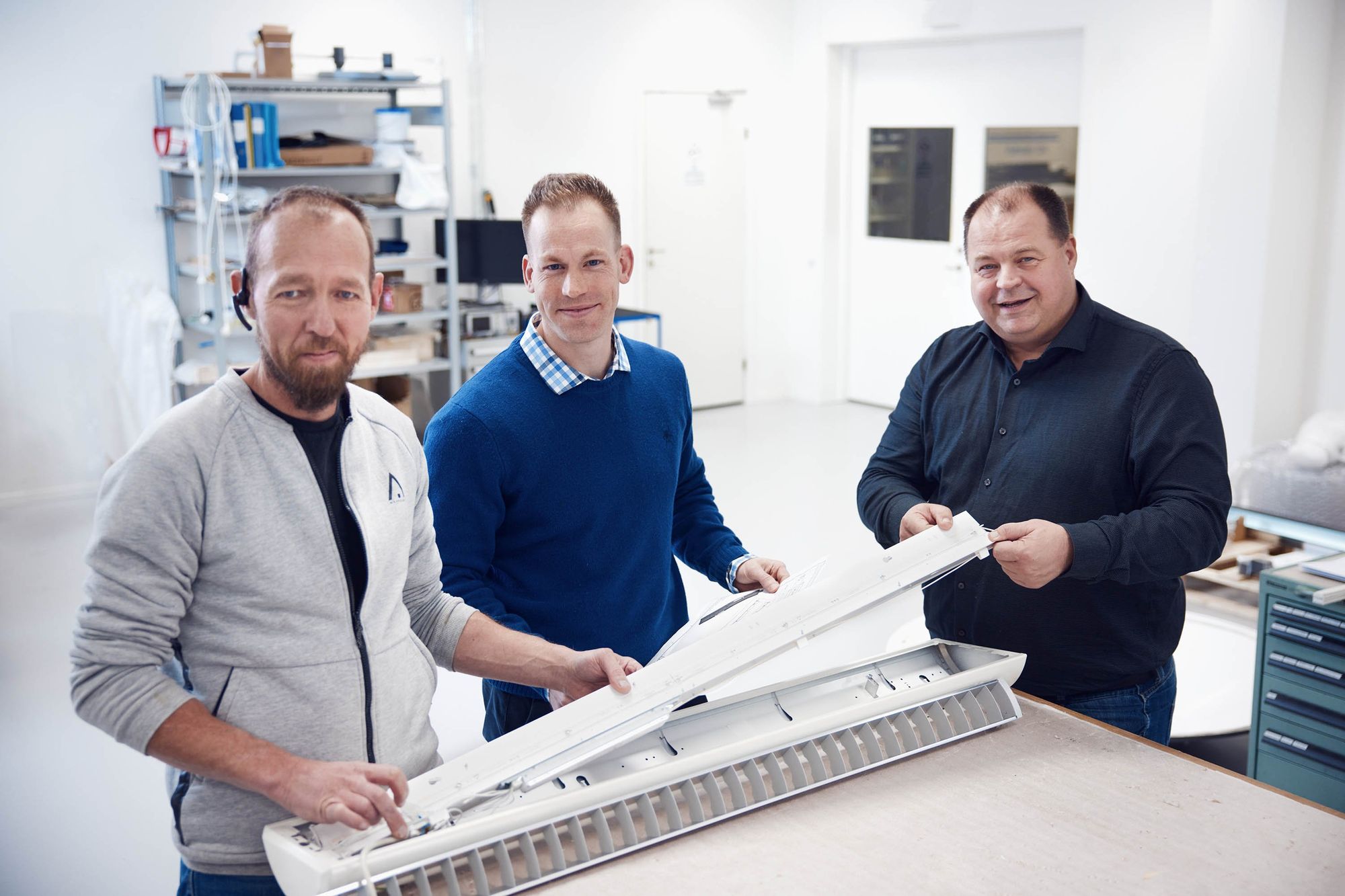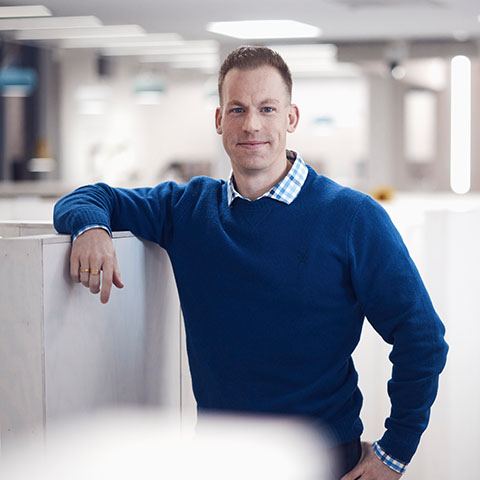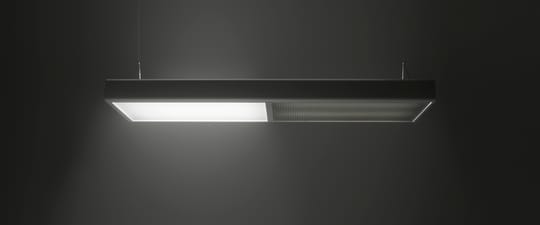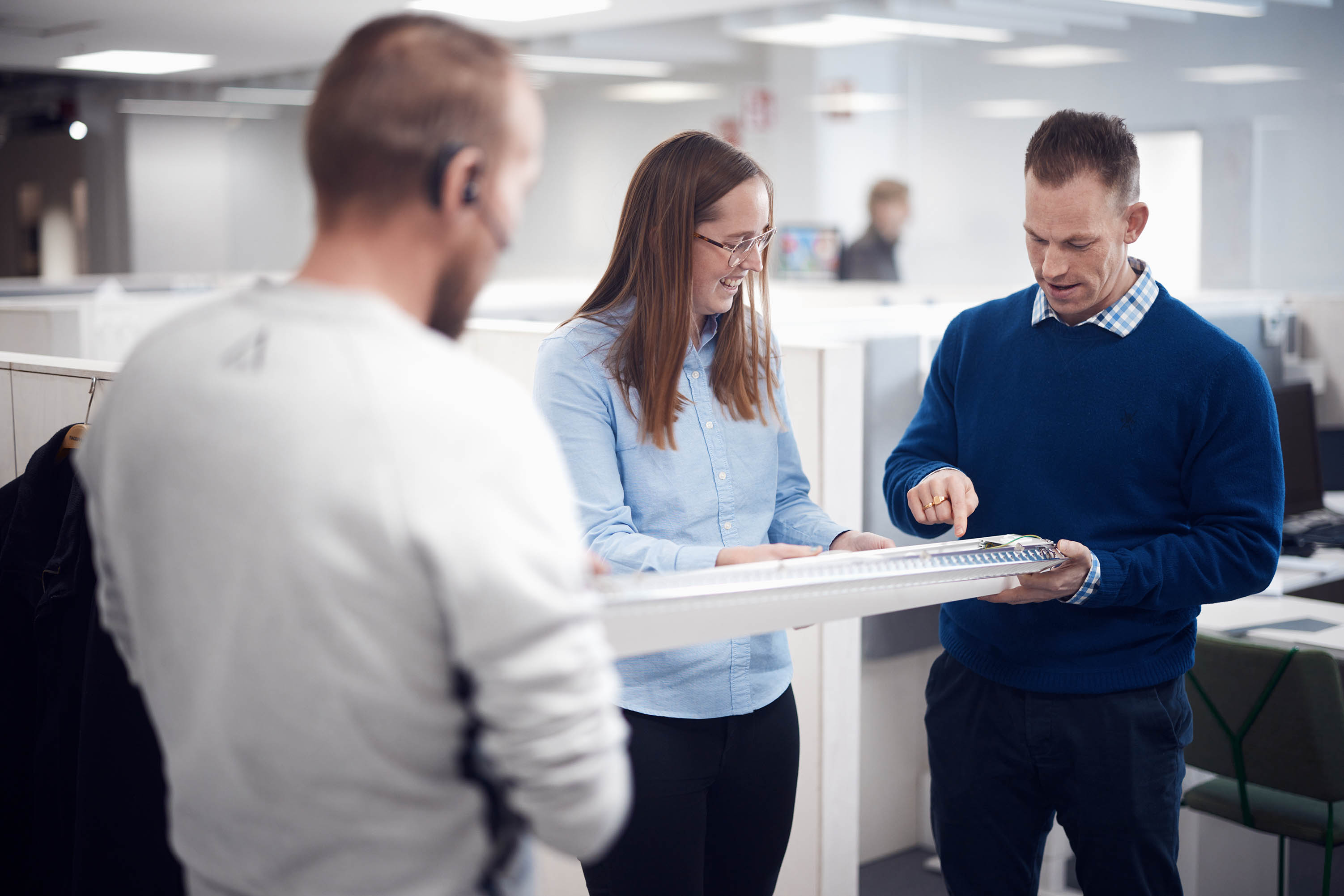
From the grave to the cradle - full circle for a luminaire
The concept of refurbishing and/or rebuilding old luminaires in order to save material and energy is a field that is rapidly growing. And sometimes, what an outdated fixture needs is some tender love and engineering skills to be able shine bright again. We have met with two of Fagerhult’s project managers, Johan Ericsson and Peter Eklund, that love a really tricky challenge. Preferably the ones that are absolutely impossible.
At Fagerhult there is a deeply rooted innovation culture that undoubtedly influences all aspects of the work. Possibly it springs from the founder Bertil Svensson’s mindset of solving problems with sometimes small means, but with a lot of curiosity and stubbornness. Even though sustainability was not a buzzword during Bertil’s days, durability and quality have always been cornerstones for the company. And the ongoing climate awareness has urged us all to challenge previous ways of thinking, and made us conscious of new fields possible for more long-lasting solutions.
For many years, BESPOKE LIGHTING SOLUTION (BLS), Fagerhult’s bespoke development department has developed unique luminaires and adapted solutions. They produce newly built luminaires, and refurbished and updated old fixtures - but has not previously had an outspoken sustainable agenda as motif from their clients. But the will and interest to refurbish and rebuild old luminaires is a sustainable trend that is increasing. A process in which yesterday’s design and technology are brought up to speed by todays advances, in order to meet the requirements of tomorrow.
 "It is more frequent now, than previously, that our clients has an outspoken will to save materials and energy in their projects." Johan Ericsson, project manager
"It is more frequent now, than previously, that our clients has an outspoken will to save materials and energy in their projects." Johan Ericsson, project manager
Rebuild, refurbish or repair?
Johan Ericsson and Peter Eklund are both project managers at BLS, where unusual questions and close to impossible solutions are a part of their everyday work. Together with their colleagues, they manage inquiries from all Fagerhult’s markets, regarding special developed lighting solutions for different projects. But what kind of projects choose to refurbish, instead of investing in a new luminaire – and why?
– There are many different reasons as to why a luminaire might need to be rebuilt or refurbished instead of just replaced, Johan Ericsson explains further. There are circumstances when the luminaire is a part of the aesthetics or the design of the premises and cannot be replaced or altered. In other cases the luminaire is a part of the construction, or is built in a way where it cannot be removed, just updated. In yet other cases, and that is more frequent now than previously, there is an outspoken will to save materials and energy – and make an environmental effort by updating the luminaires instead of buying newly produced ones.
– No matter what the background is, the main focus for us is – as always – to help the client to solve the problem at hand, says Peter Eklund. In order to do so we have different solutions for different situations. But all our solutions are carefully evaluated before suggested to the client, whether it is to refurbish, rebuild or develop a new luminaire. For us, the quality of the product and its outcome, is the most important part of the process. Apart from making our client satisfied, of course.
Safty first
No matter the project, safety and quality are the red thread combining all Fagerhult’s products. And the special projects are sure to be no exceptions. But to be able to guarantee a secure and comfortable lighting solution it needs to be tested. For refurbishment projects that could seem like a tricky part, but there are solutions even for this. Peter Eklund explains:
– A crucial issue is the CE-marking and testing in cases like these. The request from our Technical Centre is that we deliver a unit that is as close to a complete luminaire as possible. If we send loose parts that are assembled on site, we cannot guarantee the quality of the end product. But if the LED package is assembled and tested in our centre, as a unit, we can ensure that it works and keep up to standards even when it is inserted in the old luminaire body.
– In these cases, we have made calculations to ease the assembling part as much as we can, Johan Ericsson develops further. We produce the new light packages so that they fit into the old screw holes, to facilitate installation as much as possible.
 "No matter what the background is, the main focus for us is – as always – to help the client to solve the problem at hand." Peter Eklund, project manager
"No matter what the background is, the main focus for us is – as always – to help the client to solve the problem at hand." Peter Eklund, project manager
Old and used or old and gold?
In a very environmental aware era, it is easy to get caught up in the will of doing something good, when the outcome might in fact be the very opposite. Not all old luminaires are meant to live forever, some of them are outdated and is better to be recycled instead of refurbished. Johan Ericsson explains:
– We have already pinpointed a few luminaires in our range where we know that it is more efficient to actually buy a new luminaire, than refurbish an old. This because in the process of updating it, we need to add as much new material as in a new luminaire. Then we also have the aspect of lighting comfort. Some of the old design and materials are just not as good as today’s modern techniques. And I don’t think you should forget the aesthetic aspect, since people do have these fixtures in their working environment in some cases. Even if a luminaire can be ledified, it may not be certain that it is nice and cheeky to have in your office today.
– No matter the reasons, we always calculate and balance the effort and gain by rebuilding, refurbish or updating an existing luminaire compared to buying, or developing, a new one, says Peter Eklund. Our primary goal is always that the client is equipped with the best lighting solution for the project, and we want it to be safe and secure – whether it might be a refurbished luminaire or a new one. We would never do a refurbish project if it is not the best solution for the client and the environment. Some products are suitable and others not, and we have the competence to make that decision.
TEXT MARIA VÅRENIUS
PHOTO PATRIK SVEDBERG

Read more about Re:Furbish
Re:Furbish is an initiative within Circular solutions – one of our four sustainability focus areas. By upgrading and improving existing luminaires, we can jointly create major benefits for the climate, the project’s economy, and future lighting comfort.
Read moreRelated News

When material matters – Wrapped adds a new view on sustainable lighting
In a world where every gram of material and every gram of carbon dioxide counts, Wrapped emerges not just as a luminaire – but as a statement. It’s Fagerhult’s most sustainable pendant to date, and it didn’t happen by accident. Every detail, every decision, every material was chosen with intention. Sustainability often starts with a simple question: What is it made of? For Wrapped, the answer is a trio of materials that each carries its own environmental story. Solid board: a familiar friend At Fagerhult, we first met Solid board in 2021 with Multilume Re:Think. But for Wrapped, we’ve taken it further. The material consists of a three-layer construction featuring a 100% recycled core, a renewable FSC-certified top layer, and a thin protective plastic film. All in all, a material that’s 65% recycled – and a 89% reduction in CO₂ emissions compared to virgin extruded aluminium. Image gallery: Solid board Wrapped is made of organic Solid board, recycled aluminium and post-consumer recycled plastic. Reimagining plastic Plastic is often a hot topic in sustainability conversations. But not all plastic is created equal. Wrapped uses post-consumer recycled plastic: the kind that has lived a life before, perhaps as a shampoo bottle or food container. Pre-consumer plastic, on the other hand, is different as it never made it to the shelf. Quote: Josefin Carlsson Aluminium with a past Inside Wrapped, two structural components are made from 100% post-consumer recycled aluminium. This material is also part of a circular infrastructure – and may even have been part of a Notor luminaire once. Compared to virgin aluminium, this choice reduces emissions by 83%. Designing with less - built to last However, sustainability isn’t just about what you use – it’s about how much. At just 900 mm, Wrapped is shorter than a conventional 1200 mm pendant. That reduction in size alone cuts the climate impact by 25%, without compromising the luminaire’s lighting performance. Josefin Carlsson compares the climate impact of products in Fagerhult's Experience Centre in Habo. To understand the impact of Wrapped, it helps to look at where we started. In 2021, Notor 65 – made from virgin aluminium – had a climate impact of 34 kg CO₂e. By 2024, with 75% recycled aluminium, that number was reduced to 25 kg CO₂e. Today, Wrapped comes in at just around 12 kg CO₂e. “That’s a third of the original Notor 65, and half of the current version, and a quiet revolution, measured in kilograms of CO₂e,” says Josefin Carlsson. After its long life – estimated at 100,000 hours – Wrapped is ready for an equally sustainable exit. Its design makes it easy to disassemble, with each material being recyclable and prepared for its next chapter in the circular economy.
Fagerhult uses recycled aluminium for high-volume products — ensuring circular use of resources
With a focus on reducing its long-term greenhouse gas emissions, Fagerhult now choose extruded aluminium profiles containing 75% recycled material from end users. The material is used for product families manufactured and sold in larger volumes — and where the material can make a real difference. The initiative reduces Fagerhult’s climate footprint by approximately 225 tons of CO2e per year.Aluminium is a lightweight and durable material that can be reused multiple times if recycled properly. Its environmental impact depends on several factors, including whether it is made from virgin aluminium, how it is produced, whether fossil fuels or renewable energy sources were used in its production, and if it is derived from recycled materials.Niclas Thulin is Sustainability Manager at Fagerhult:“We are taking a significant step forward by moving from renewably sourced aluminium to recycled aluminium (post consumer). The Notor family – together with several other product families – is now made of extruded aluminium that is 75% recycled. This results in around 70% lower climate impact than the average impact from European primary aluminium and 88% lower than the global average for primary aluminium*.”The change affects products sold in larger volumes. The products Notor 65, Notor Recessed, Notor 36, Fjord, Vil, Multilume Hydro, and Sentra are now made of recycled aluminium.“We intentionally upgrade the materials for our larger product series because it significantly impacts Fagerhult's greenhouse gas emissions. For the Notor family alone, we used approximately 65 kilometres of aluminium profiles in 2024, and nearly all of this volume has now been replaced with recycled material,” says Niclas Thulin.The change is part of Fagerhult's systematic sustainability work and a considerable step in reducing greenhouse gas emissions in Scope 3: the company's indirect emissions from purchased materials. The Science Based Targets validate Fagerhult's climate targets, and the ambition is to achieve net zero emissions from the entire value chain by 2045.“This is our most important decision regarding materials, at least with reduced climate impact as the fundamental incentive. The majority of our emissions come from Scope 3, and through this change, we are making a difference where it has the greatest impact. Based on last year's volumes, the switch to recycled aluminium can reduce emissions by approximately 225 tons of carbon dioxide equivalents annually.”*Climate impact excluding the extrusion process. EPD compared to the European average for primary aluminium (European Aluminium) and the global average for primary aluminium (International Aluminium).
